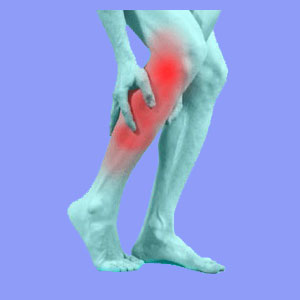
Sciatica in the calf is one of the most common locations to experience radicular back and leg pain. Symptoms often exist in the rear of the muscle, but also may exist in the outer side of the muscle in many cases. Pain, tingling, weakness and/or numbness may be unilateral or bilateral and may be completely centered in the calf exclusively or may also affect other anatomical regions in the lower body. As is typical for most cases of sciatica, the symptomatic expression is often highly individualized with every person demonstrating a unique painful complaint which may or may not make sense from an anatomical evidence perspective.
This narrative details sciatic nerve expressions in the calf muscles of one or both legs.
Sciatica in the Calf Causes
Nerve issues in the calf related to a spinal causation are usually linked to L5 or S1 concerns, although L4 can be implicated in rare instances. Many patients are diagnosed with L5 or S1 nerve compression due to herniated discs or arthritic osteophytes. However, in many instances, these diagnostic theories turn out to be incorrect and the structural issues located on MRI or CT scan are purely coincidental and asymptomatic.
Remember, the nerve will have to be definitively compressed in order to elicit symptoms. This is rarely a verified conclusion in relation to a lumbar disc issue. Unfortunately, most patients do not find out the incorrect nature of the diagnoses until they have tried a variety of unsuccessful treatments and possibly endured a failed sciatica surgery or two.
A bit of proactive research probably would have shown them the folly in the diagnosis much earlier, since symptoms are usually far too widespread to be accounted for from a single spinal level nerve compression issue. Of course, in some cases, the diagnosis of nerve compression is correct, symptoms do correlate and treatment should be successful. In other cases, there may be another reason for widespread leg pain concerns to exist, such as higher level central spinal stenosis affecting the actual spinal cord in the neck or middle back.
Sciatica in the Calf Anatomy
The calf muscles, along with most other areas of the leg, are certainly innervated by the sciatic nerve. Problems which affect the entire sciatic nerve are usually far more logical as diagnostic theories than single level spinal issues, particularly when pain exists in large areas of the lower body, without strictly defined correlating symptoms, such as foot drop or loss of reflex.
Piriformis syndrome is the most common structural theory used to explain widespread sciatic nerve complaints. However, although the piriformis may be involved in the pain, it is almost never the actual causative source. In some cases, ischemia is to blame, and spasms which result in the piriformis are a direct result of the oxygen deprivation process. This is a proven source of pain rarely identified by medical doctors.
Calf pain, without other sciatica symptoms being present, may be the result of a localized nerve dysfunction, soft tissue injury, repetitive strain syndrome or other concern. In rare cases, varicose veins can cause calf pain, as can the growth of cysts, lipomas or tumors in the region.
Sciatica in the Calf Synopsis
Sciatica in the calves can be torturous. It can enact charlie horses, spasms and weakness in one or both legs, making virtually any position torturous. I suffered with many bouts of this myself and still get them on occasion. Most of my own calf pain comes when I am in bed. Somehow, reclining always has the possibility of exacerbating my sciatica suffering. No fun to be sure.
As always, I recommend that patients with defined patterns of pain read more about their diagnoses and look for any inconsistencies which may explain why treatment has not helped. Patients without defined or explained pain patterns need to go one step beyond, since they often do not even have a working diagnostic therapy in place. When it comes down to it, the chances of finding a cure are almost zero, unless a successful and accurate diagnosis is made first.





